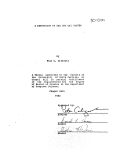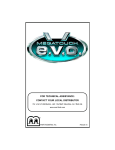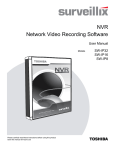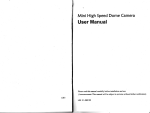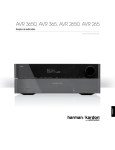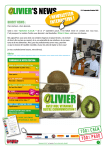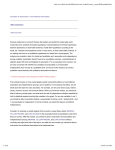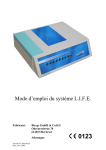Download mimmi? @é@@@@@@@
Transcript
US006134564A United States Patent [19] [11] Patent Number: Listou [45] [54] [75] COMPUTER PROGRAM FOR RAPIDLY Date of Patent: 6,134,564 Oct. 17, 2000 Primary Examiner—Stephen S. Hong CREATING AND ALTERING PRESENTATION OF PARAMETRIC TEXT DATA OBJECTS AND ASSOCIATED GRAPHIC IMAGES An apparatus, method and article of manufacture of the Inventor: Robert Listou, Washington, DC. present invention provide the ability to rapidly format and reformat tabular displays, organized according to the pref [57] ABSTRACT erences of the user, of records or text data objects that may [73] Assignee: ExecWare, Inc., Washington, DC. have associated graphic images and/or audio ?les. The invention provides simpli?ed, interactive means for naming [21] Appl. No.: 09/325,358 categories or parameters associated With each text data [22] Filed: object, for assigning values to each parameter for each text Jun. 4, 1999 data object, for associating graphic images and/or audio ?les Related US. Application Data [63] With each text data object, and for constructing a sort order for displaying a list of selected text data objects. The features of the present invention alloW a user, Without need for specialized training or a user manual, to rapidly vieW the same or different lists of text data objects from differing Continuation-in-part of application No. 08/561,178, Nov. 20, 1995. [51] [52] [58] Int. Cl.7 ...................................................... .. G06F 7/08 US. Cl. ........................................... .. 707/505; 707/526 Field of Search ................................... .. 707/503, 504, perspectives, Without cumbersome steps that could interrupt the user’s line of thought. The present invention alloWs the user to then vieW graphic images associated With individual text data objects and hear associated audio ?les. The present invention has application to any situation that Will bene?t 707/505, 509, 526, 529 [56] References Cited PUBLICATIONS from the systematic planning, monitoring, and/or analysis of Microsoft (R) WindoWs NT(R) Version 4.0, 1996, screen printouts pp. 1—4. Simpson, Mastering WordPerfect 5.1 & 5.2 for Windows, Sybex Corporation, 1993, pp. 586—593. a plurality of text data objects and associated visual and aural information. 3 Claims, 13 Drawing Sheets View Add Edn Delete Mark? Links’7 T TF1]; Pm“ A" Maienal 1202 1201 Mark 1204 1205 1203 1206 J 1207 1209 1208 1212 1210 1211j 1213 mimmi? @é@@@@@@@ 1200 U.S. Patent 'I Oct. 17, 2000 Sheet 1 0f 13 6,134,564 CENTRAL PROCESSING UNIT SDTOIRAGKE 102 CONTROL 108 118 DISPLAY KEYBOARD PRINTER 110 1 12 116 FIG. 1 U.S. Patent 0a. 17, 2000 Sheet 2 0f 13 K , 6,134,564 201 IMAGE QUERY DIALOG BOX I K202 DESIGNATE VALUES FOR PARAMETERS I K203 CONSTRUCT SORT ORDER I / 204 SELECT DATA Ir / 205 SORT DATA I 2 206 <-—— DISPLAY DATA > I / 207 HIGHLIGHT I K208 DISPLAY EDIT DIALOG BOX I <— EDIT Fig. 2 K 209 2 210 PRINT U.S. Patent 0a. 17, 2000 Sheet 3 0f 13 303 304 301 302 305 306 307 :1 e3 :3 J a3 e3 :1 Add Query Exit Help ‘Digger Piazza Calendar 300 Fig. 3 6,134,564 U.S. Patent 406 Q) Save 401 1 \ 402 404 l / Sheet 4 0f 13 403 6,134,564 405 / Cancel I Help / / / I 400 0a. 17, 2000 I Change Alpha I I / Name/he Parameters A‘ I Change Delta w m@ B Alpha N [I Numeric Date U Date Change Beta Change Epsilon toll-XE: [3 Alpha N I] Numeric [:I Date to I: Alpha N [:I Numeric [I Date Change Gamma Change Zeta w@ B Alpha N to: B Alpha N El Numeric D Date |:| Numeric [:I Date Fig. 4 U.S. Patent 0a. 17, 2000 506 505 .2 .2 Save Close Cancel Sheet 5 0f 13 6,134,564 Help Enter Parameter Values 500 \ Grid Color F IH I Type I IVI /-->Material J Copper 501 / 504 J Brass V _V_ Bronze Clay Marble Wood T / 502 503 Fig. 5 IV] U.S. Patent 608 0a. 17, 2000 609 F ‘/ / |—L_|Note Note Anached Sheet 6 0f 13 601 / ,1 Add Items I @j [E @| 611 Item Identi?er I 1 Parameter Values 600 6,134,564 J / Related Items (Links) Grid \ IA? Ivl [Pitcher I“ I WI IN I NI 0 [ |v| l WI Type [87 1tl*'_\\ Material \ [Clay \ /’ 602 Color Black Blue 1w Bronze (\ Description Brown T I 606 \\_> l / I 7 / I 607 / 605 I l l 604 610 U.S. Patent 0a. 17, 2000 702 l J j I 700 \L 707 \ 708 701 I l \ BuildlQuery use saved Query #335 * -Select All But Grid HeSetA" Sort 715 I I / / Reset E1 6,134,564 710 / I i1 @// 712 ReSetA" El m I! T pe III \ Sheet 7 0f 13 711 (3) Grid J/ r/i” mumps 704 Material Mm [Em III Color mw Material I 1/’ U |..A“..—|T‘ U l2‘ CO‘OI' 703 D 705 [:1 Savethis query as] I T 713 / 4/ I | Save | \ | 706 714 U.S. Patent 0a. 17, 2000 809 807 800 808 806 I Add Edit Delete 801 Mark? Links? Type ‘ Sheet 8 0f 13 803 810 View Mzrr'féd Mark Material 804 805 M5?‘ unmfrk Close Grid 802 Fig. 8 Color 6,134,564 U.S. Patent 906 | l/ | Note Note Attached Item Identifier | 3 900\. 0a. 17, 2000 901 Sheet 9 0f 13 902 \\ \ \\ 904 |\Editltems i/ [ Pre: Grid Z N'ext l Print Save ||Cancel| 903 Related Items (Links) —————-— E U // lll ivl El :2 El |——_—:E] Material [Bronze 905 | Parameter Values lA7 Type lcup 6,134,564 I“ Color |Bronze El ‘:12 El l:?] El l_——__—_l? Description IE] Fig. 9 U.S. Patent 0a. 17, 2000 Sheet 10 0f 13 EM0721 wm3<> AoExméo?; 6,134,564 a mo \ r $5261 2965m w0Eo6ézamg 2.mm a Fo \ ? Emwoza<w @2E9w0n5omv % U.S. Patent 0a. 17, 2000 Sheet 11 0f 13 View Query Add Edit Delete Mark? Links? Type M2112; Material Mark M?k Grid Pitcher Pitcher Pitcher Pitcher Fig. 11 6,134,564 U.S. Patent 0a. 17, 2000 Sheet 12 0f 13 1202 1201 ,J , All Saved 1207 1204 1205 ,J J Auto 6,134,564 1209 1212 12031206 J 1208j 1210 1211 l ,1 W Manual Start , ,J , 523 1200 Fig. 12 Stop Next ,i ,1 r Previous Add 1213 g Delele Close U.S. Patent 0a. 17, 2000 Sheet 13 0f 13 6,134,564 1 302 @ M @ 19% @1303 Fig. 13 6,134,564 1 2 COMPUTER PROGRAM FOR RAPIDLY CREATING AND ALTERING PRESENTATION OF PARAMETRIC TEXT DATA OBJECTS AND ASSOCIATED GRAPHIC IMAGES cities, a spreadsheet typically could provide a total of the population ?gures for selected cities. Current art also enables the operators of some spreadsheets to create three dimensional graphs of numbers displayed in the spreadsheet, With each axis of the graph representing one of the param eters listed in the same roW as the numbers. If there are more than three parameters, the operator can create several graphs This is a continuation-in-part of application Ser. No. With varying dimensions. Analysis of several such graphs 08/561,178 ?led Nov. 20, 1995. BACKGROUND OF THE INVENTION The basic invention is unchanged but the design is improved. An addition to the design substantiates a change of the title so it accurately describes the improved invention. This invention relates generally to the ?eld of information processing and display by computers and, more particularly, 10 a spreadsheet, relocate columns and roWs. The operator cannot, hoWever, easily and quickly revise the contents of a roW; and spreadsheets typically do not have the capability to search for records rapidly. 15 to a computer-implemented method for sorting and display ing text data objects that permits rapid re-sorting and re-formatting of displayed text data objects and perceiving associated graphic images and audio ?les. data may not adequately serve the needs of some users, among elements in large sets of data. Existing programs typically focus on presenting the data, rather than on pro Database management systems today generally provide viding the ability rapidly to draW conclusions from the data by rearranging it to perceive relationships that are not for the creation, storage, and display of large quantities of 25 apparent on a static table. Other tables are used to select individual records With Which images are associated, or to vieW images to access related text data. There are no means to vieW and analyZe sets of data, both the textual parameters of records and associated graphic images, in a Way that gives the user the ability to immediately manipulate (model) the data. Frequently, in existing programs, it is not possible to select different sort parameters and differing subsets of the employee number, address, Social Security Account Number, gross pay, along With a unique date. And perhaps a graphic image depicting the person’s face. An operator of the database can design tables that display selected records as roWs With the columns of data parameters arranged in a particular desired order. Mathematical operations can typi cally be performed on columns containing numeric data. HoWever, the relationships betWeen and among the data 35 substantial training, familiarity With user manuals and, in some cases, specialiZed personnel. The present invention derives from the observation that individuals Who must draW conclusions from tables of text record appears complete. data objects and associated graphic images and/or audio ?les In the existing art, tabular displays of records can be have needs not met by currently-available database man designed as desired. HoWever, if examination of a table agement systems and spreadsheet programs. An individual’s suggests a change in a record or consideration of a different analysis occurs in the context of the broader range of 45 knoWledge and experience that he or she brings to the situation. Accordingly, this analysis Will be enhanced by exercising personal control of the format of the presentation of text data objects and associated graphic images and/or designed by those Who Will employ them for draWing conclusions, and seldom does the user of a table have ready ability to manipulate the database in order to reformat or audio ?les. Users of databases need more than the ability to rearrange the table. If a record needs to be changed or a neW in?uence the design of the tables; they need the ability to relate interactively With the tables to quickly revise the format to match the rapid, complex and intuitive probing of table format is desired, it may take considerable time to produce a table re?ecting the changes. Even if the user is the operator of the database management system, time Will be the thought process. In particular, users of databases need required and the user’s current line of analytic reasoning may be lost. Existing electronic spreadsheet programs, such as Lotus 1-2-3TM and Microsoft EXCELTM, can also involve text and numeric data arranged in tabular form. Typically, each roW in a table concerns a unique subject, and the cells making up the roW contain textual or numerical data setting forth parameters or characteristics of the subject. For example, a data Without a series of precisely-speci?ed steps that can frustrate a user interested in quickly pursuing many varying lines of thought. Often, operation of such programs requires parameters of such a table may not be readily apparent. Typically, the purpose for revieWing such a table is to ascertain that all desired records are listed and that each table format, the user must usually interrupt his or her current line of thought. Tabular data displays are seldom Thus, While computer database management systems and spreadsheet programs With data-sorting capability have been Widely available, existing systems and programs for sorting especially those Without specialiZed training or experience attempting quickly to discern relationships betWeen and DESCRIPTION OF THE RELEVANT ART both numeric and text data as Well as graphic images. For example, a company may maintain a database of employee payroll records. In such a database, a series of payroll checks to Jane Doe may be stored as a large number of records, all With identical data elements or parameters such as name, can disclose relationships that cannot be perceived by look ing at a single graph. The operator can usually, upon vieWing interactive capabilities (1) to change parameter values of 55 individual text data objects contained in a table and to immediately see hoW that change affects the location of text data objects in the table; (2) to add or delete text data objects and immediately to see the results; and (3) to reformat tables displaying text data objects. Because these capabilities enable users quickly to perceive relationships betWeen objects in several Ways, analysis of individual text data roW might represent a record concerning a particular city, objects as Well as entire databases of text data objects and and the cells Would include text and numeric data that can be used in computations such as population, area, or number of schools. Formulas can be entered into cells of the spread sheet so that data can be aggregated or otherWise manipu Perceiving those relationships rapidly, and in the context of related data, the associative ability, and intuition in the user’s mind (including those generated during the processing) is at lated. For instance, in a table listing population data for associated graphic images and audio ?les can be enhanced. 65 the heart of the invention. The name given to that cognitive 6,134,564 3 4 process by the applicant is contextual data modeling. It has matically at a speed determined by the user, to control the application in any situation involving planning, monitoring, successive display of tables it is apparent that all possible and/or analysis of a large population of teXt data objects. arrangements of columns are in fact available to the user, an important feature because of the large numbers of possible arrangements (24 With 4 parameters, 120 With 5 parameters, and 720 With 6 parameters). Also, according to the present invention, a computer OBJECTS AND SUMMARY OF INVENTION The subject of the present invention is the display of a columnar list, or table, of teXt data objects on a suitable device controlled by a computer, such as a monitor. In this invention, a teXt data object is an item, such as a teXt record, to Which parameters have been associated and to Which 10 a program directing a computer system to effectuate the graphic images and/or audio ?les may be associated. The principal object of the present invention is enabling persons Who draW conclusions from the table of teXt data objects to personally and rapidly reformat the table in order to perceive a plurality of relationships betWeen the displayed values of the parameters. AnalyZing relationships betWeen those non-numeric values by reformatting the table is analo gous to analyZing relationships betWeen numeric values in database records by creating graphs. In this invention refor system comprising means for effectuating the method of the present invention is provided. Further according to the present invention, computer-readable memory encoded With 15 method of the present invention is also provided. Additional objects and advantages of the invention are set forth in part in the description that folloWs, and in part are obvious from the description, or may be learned by practice of the invention. The objects and advantages of the invention may also be realiZed and attained by means of the instru mentalities and combinations particularly pointed out in the appended claims. mat means change appearance or change contents. BRIEF DESCRIPTION OF THE DRAWINGS Another object of the invention is to provide a simpli?ed method for a user to select teXt data objects to be sorted and for choosing the format of a table for displaying the sorted teXt data objects. Another object of the invention is to provide a method for the user to perceive graphic images associated With teXt data objects as part of the user’s analysis of the displayed table of teXt data objects. Similarly, listening to associated audio ?les becomes part of the analytic process. According to the present invention, as broadly described 25 The accompanying draWings, Which are incorporated in and constitute a part of this speci?cation, illustrate particular embodiments of the invention, and together With the description, serve to explain the principles of the invention. This Continuation-In-Part application presents draWings and Detailed Description that illustrate the original invention and also the improvements. One improvement is the auto matic display of various tables of selected teXt data objects to facilitate the vieWing of large numbers of arrangements of the columns of parametric values included in those tables. herein, a method is provided to display on a computer Another improvement is associating graphic images and controlled display device, such as a monitor, a Build Query audio ?les With teXt data objects so that they can be vieWed, or hear, as part of the process of modeling tables of teXt data dialog boX in Which appears a plurality of names of param eters that have previously been assigned and associated With teXt data objects. Further according to the present invention, the user is permitted to vieW possible values that have previously been assigned to each parameter, choose them or 35 objects. FIG. 1 is a block diagram of a computer system as may enter neW values to select teXt data objects, and designate the sort order. In this invention select means specify Which be utiliZed by the present invention. FIG. 2 is a How diagram shoWing the overall operation of the present invention. parameters and associated values the computer system is to satisfy in retrieving teXt data objects from the database for eXemplary opening display for a computer program in display on the table, and sort order means the order in Which the columns of parameter values Will appear on the table. Further according to the present invention, the user vieW FIG. 3 is an illustration of a display screen shoWing an accordance With the present invention. FIG. 4 is an illustration of a display screen shoWing an 45 eXemplary dialog boX for choosing parameter names and ing the table may quickly return to the Build Query dialog types. boX to select a different set or subset of teXt data objects and/or revise the sort order. The invention alloWs the user to eXemplary dialog boX for assigning values to parameters. format and re-format the table, Within seconds, to perceive values of teXt data objects from many different perspectives. Another object of the present invention is permitting the user to rapidly change the parameter values of teXt data eXemplary dialog boX for creating teXt data objects With associated parameter values and images. objects displayed on the table and immediately see on the eXemplary dialog boX for constructing a query. table the re-sorted results of such parameter value changes. Another object of the present invention is permitting the user vieWing the table to rapidly add teXt data objects to it FIG. 5 is an illustration of a display screen shoWing an FIG. 6 is an illustration of a display screen shoWing an FIG. 7 is an illustration of a display screen shoWing an 55 and immediately see on the table the re-sorted results of the FIG. 9 is an illustration of a display screen shoWing an expanded table. eXemplary Edit dialog boX for revising and adding informa tion related to a teXt data object. Another object of the present invention is permitting the FIG. 10 is a How diagram shoWing methods available to the user for modeling the display of teXt data objects. user to rapidly vieW a plurality of tables of teXt data objects With all possible arrangements of the columns of parameter values. According to the present invention, there is stored in the computer system a static pattern that de?nes all possible arrangements of the columns of parameter values. When the computer system uses that pattern, either manually or auto FIG. 8 is an illustration of a display screen shoWing an eXemplary table as may be displayed and used in an illus trative embodiment. FIG. 11 is an illustration of a display screen shoWing an 65 eXemplary table as may be displayed and used in an illus trative embodiment. FIG. 12 is an illustration of a display screen that is used to control the automatic display of all possible tables of 6,134,564 5 6 selected text data objects, each table With a different arrange ment of the columns of parametric values of the text data point-and-click mouse device. The several steps depicted in the flow diagram of FIG. 2 requiring user input are prefer ably accomplished by a user of the computer system sig naling the system through the use of a point-and-click objects. FIG. 13 is a flow diagram showing the interactions betWeen and among a Build Query dialog box, a VieW Query device, such as a mouse. The steps required to program a computer system to accept suitable signaling and to display screen, an Edit screen, and the user’s mind in a preferred the screens depicted in FIGS. 3—12 are Well knoWn to one of embodiment. ordinary skill in programming for WindoWsTM applications. DETAILED DESCRIPTION OF THE PREFERRED EMBODIMENTS This invention is described herein With reference to 10 A computer system as may implement and execute the present invention is described With reference to FIG. 1. Such situation Warranting systematic planning, monitoring, and/or analysis of a plurality of text data objects and associated a computer system generally may comprise a processing means (102), such as a central processing unit (CPU), for processing information; a memory (104) for storing infor graphic images and/or audio ?les. 15 mation and instructions for the processor, preferably includ ing a dynamic storage means (such as random access memory and a static storage means (such as read only memory (ROM)); a data storage device (106) such as a magnetic disk and disk drive for storing information and instructions; a control means (108) for controlling input/ output operations and the interaction betWeen the processor (102) and the memory; a display device (110) such as a cathode ray tube or liquid crystal display for displaying a cursor and information to the computer user; an alphanu analyZing archaeological data. Other potential uses include criminal investigation, historical analysis, and any other 25 meric input device (112), such as a keyboard, including alphanumeric and other keys for communicating informa FIG. 3 is a depiction of an exemplary menu screen (300) that appears When the user begins each use of a preferred embodiment of the present invention. From this menu screen, the user has the option of calling up screens that Will alloW her to implement the invention. Thus, clicking on “Parameter Names” (301) calls up the display screen depicted in FIG. 4, Which in turn permits the user to assign parameter names and types. Clicking on “Parameter Values” (302) calls up the display screen depicted in FIG. 5, Which permits the user to assign values to parameters. Clicking on “Add” (303) calls up the display screen depicted in FIG. 6, Which permits the user to create text data objects, assign parameter values to the text data objects, and to create links cursor control device (114), such as a point-and-click mouse betWeen text data objects. Clicking on “Query” (304) calls up the display screen depicted in FIG. 7, Which permits the device, trackball, joystick, or light pen, for communicating user to construct a query that Will determine the format of information and command selections to the processor (102) and for controlling cursor movement. It is useful if the system includes a hard copy device (116), such as a printer, the table to be examined. system may include a modem (118) for communicating With century. Clicking on “Exit” (306) initiates the process of computer systems at remote locations. exiting the computer program. Finally, clicking on “Help” tion and command selections to the processor (102); and a The “Calendar,” “Exit,” and “Help,” functions depicted in FIG. 3 are Well knoWn in the art. Clicking on “Calendar” for providing permanent copies of information. Finally, the 35 (305) calls up a calendar that preferably spans an entire (307) gives the user access to the help program associated With the invention. FIG. 2 is a flow diagram depicting the overall operation of the invention. While the invention can be practiced in a manner different from that depicted in the flow diagram, the flow diagram provides a useful overvieW for understanding the invention. The invention involves, among other things, the use of a computer system, such as depicted in FIG. 1, to sort and display text data objects stored in the computer system. As shoWn in FIG. 2, the invention comprises the steps of imaging a query dialog box on a display device controlled by In a alternative embodiment the display screen illustrated on FIG. 3 Will alloW the user to select one of several databases for current operations. Thus, for example, an archeologist can have a separate database for each archeo logical dig, and a detective can have a separate database for 45 each criminal case. FIG. 4 is an illustration of a display screen shoWing an exemplary dialog box (400) for choosing parameter names the computer system, With the query dialog box displaying and types. In a preferred embodiment, default parameter parameters associated With each of the text data objects, spaces for listing the values associated With each parameter and a list of parameters for selecting a sort order (201); designating at least one value listed in the query dialog box for each of the parameters displayed in the query dialog box (202); constructing a sort order from a list of parameters names are Greek letters, such as Alpha-Zeta depicted in FIG. 4. Thus, the ?rst-listed parameter carries the default name displayed in the query dialog box (203); using the computer “Alpha” (401). Under each parameter name, a space (402) is provided for entering a neW name for the parameter. As depicted on FIG. 4, the user can specify Whether the param eter is an alphanumeric parameter, a numeric parameter, or 55 a date parameter. Thus, clicking on “Alpha N” (403) speci system to select the text data objects satisfying the desig nated values (204); and using the computer system to sort the selected text data objects satisfying the designated values (205). Also depicted are the subsequent steps of displaying ?es an alphanumeric parameter; clicking on “Numeric” (404) speci?es a numeric parameter; and clicking on “Date” (405) speci?es that a date is to be entered as the parameter value. Clicking “Save” (406) saves the parameter names, the sorted data (206); highlighting text data objects (207); displaying an edit dialog box (208); and editing the high lighted text data object (209). Depicted also is the step of types, and operations selected, and signals the computer to display the “Enter Parameter Values” dialog box depicted in FIG. 5. FIG. 5 is an illustration of a display screen shoWing an printing (210). In a preferred embodiment the computer system is equipped With WindoWsTM softWare and suitable display and point-and-click mouse devices Well knoWn in the art to enable a user to signal the computer system using the exemplary dialog box (500) for assigning values to param 65 eters. As depicted in FIG. 5, parameters that have not been assigned values are not displayed at all. In an alternative preferred embodiment, parameters that have not been 6,134,564 7 8 assigned names carry their default names. As shown in FIG. 5, the ?rst four parameters carry the names that Were assigned to the parameters When “Save” Was clicked on the preferred embodiment, the description can include embed ded graphic or audio ?les containing, for example, photographs, draWings, or sounds associated With the items display screen depicted in FIG. 4. Thus, for example, the third parameter is noW named “Material” (501). to be studied. In an alternative preferred embodiment an additional button, not depicted, similar to (607) and labeled, Graphics, for example, Would cause the display a dialog box In FIG. 5, clicking arroW (502) adjacent parameter value space (504) causes the computer system to display pull doWn menu (503) below parameter value space (504). Pull-doWn menu (503) displays the values that have been assigned to a parameter. For example, in FIG. 5, pull-doWn menu (503) indicates that the alphanumeric parameter into Which can be listed the ?le identi?cation of a plurality of graphic images; and a similar provision Would be pro vided for audio ?les. 10 In a preferred embodiment, clicking “Note” (608) signals the computer system to display a small space into Which a “Material” (501) has been assigned values “Brass,” “Bronze,” “Clay,” “Marble,” and “Wood.” In parameter brief note can be entered. If a note has been entered in this manner, the phrase “Note Attached” (609) is displayed, as value space (504), the user has typed “Copper” to be entered depicted in FIG. 6. The “Note attached” function thus serves as an additional parameter value. Clicking “Save” adds 15 the same purpose as a Post-ItTM or tape ?ag, to alert the user “Copper” to the list of values for the “Material” parameters, and the list is automatically resorted alphabetically and of a brief comment relating to the item. If the user Wishes to establish a link betWeen the item for displayed in pull-doWn menu (503). In a preferred embodiment, clicking “Close” (505) also Which data is being entered and another item, clicking the saves the entered parameter values and signals the computer to close the Enter Parameter Values dialog box (500) and displays the screen depicted in FIG. 3. From the screen depicted in FIG. 3, the user can then call up the Add Items all the items in the database, from Which the user can select a linked item by clicking on it in the pull-doWn menu. Clicking on an item in the pull-doWn menu causes it to be displayed in space (611) as a related item or “link.” Clicking on the item in space (611) causes the computer system to doWn arroW at (610) displays a pull-doWn menu displaying dialog box (600) depicted in FIG. 6 by clicking “Add” (303). display an Edit dialog box, such as that depicted in FIG. 9, In an alternative preferred embodiment, means are provided that enable the user to call up the Add Items dialog box (600) for the linked item. FIG. 7 depicts a screen displaying an exemplary Build directly from the Enter Parameter Values dialog box (500). The Add Items dialog box (600) depicted in FIG. 6 Query dialog box (700). Build Query dialog box (700) prompts the user to enter information relating to the different permits the user to choose, according to his or her needs or text data objects that comprise the database. For purposes of FIG. 6, each text data object constitutes an “item,” Which can be described by a set of parameter values. The dialog interests, the perspective from Which to vieW the items in the database. Clicking on arroW (701) adjacent Use Saved Query space (702) signals the computer system to display to the user a list of queries that have been previously con in the space (601) adjacent the Words “Item Identi?er.” In 35 structed and saved, and permits the user to query the database using such a saved query. the dialog box depicted in FIG. 6, the user has entered “1” as the item identi?er. In a preferred embodiment, the item As depicted in FIG. 7, in a preferred embodiment of this identi?er can be any mix of alphanumeric characters. invention, the Build Query dialog box (700) includes a box prompts the user ?rst to enter an identi?er for the item “Select” dialog box (703) and a “Sort” dialog box (704). In Select dialog box (703), the user selects parameter values for The user assigns parameter values to the item using Parameter Values dialog box (602). Parameter Values dialog box (602) lists the parameters and provides a parameter value space (603) under each parameter name for assigning a parameter value to the item. Clicking arroW (604) adjacent to parameter value space (603) under a given parameter displays a pull-doWn menu (605) listing the values associ ated With that parameter. In the example depicted in FIG. 6, the user clicked arroW (604) adjacent parameter value space (603) for the “Color” parameter to signal the computer to display pull-doWn menu (605) providing a list of colors to the text data objects to be displayed. In the illustrative examples of FIG. 7, each parameter has a space (705) beloW it, With an arroW (706) adjacent to the space. For an 45 alphanumeric parameter, clicking on arroW (706) signals the computer to display a pull-doWn menu listing all possible values for that parameter. Using Well-knoWn WindoWsTM procedures, the user can select one, all, or several of the parameter values. For a numeric parameter, the user can enter the parameter choose from. Clicking on a color from pull-doWn menu value directly into space (705), in the form of a range, a (605) causes that color to be displayed in space (603) beloW single number, or using the greater than (“>”) or less than (“<”) operators in conjunction With a number. For a numeric parameter, clicking arroW (706) signals the computer to the color parameter name as the value of the color parameter for Item 1. If the parameter has numeric values, arroW (604) is absent or inoperative and the number value for the item can be directly entered in parameter value space (603). If the parameter is a date, arroW (604) is absent or inoperative and display a mathematical operations dialog box (not depicted). 55 parameter value space (603) contains the symbols “MM/ DD/YYYY”, thereby prompting the user to enter the date in the proper format. As depicted in FIG. 6, in a preferred embodiment, after and displayed on FIG. 8. In a preferred embodiment, the user can select “total,” “average,” “standard deviation,” or a formula input by the user. For a date parameter, clicking arroW (706) signals the computer to display a dialog box (not shoWn) With four choices: “On,” “On and Before,” “On and After,” and assigning parameter values for an item the user can add a description (606) of the item. Clicking on space (606) alloWs the user to type a description in space (606). In a preferred embodiment, the length of the description has no ?xed limit, and if it exceeds the space provided by text space (606), the user can click “Expand” (607) to vieW a full-screen scrol lable dialog box that displays the entire description. In a The mathematical operations dialog box alloWs the user to select, using Well-knoWn WindoWsTM procedures, the type of mathematical operation to be performed by the computer “BetWeen.” Clicking one of the ?rst three choices causes the 65 clicked Word or phrase to appear in space (705) adjacent the symbols “MM/DD/YYYY”. The user then can type the desired date over the symbols. Clicking the “BetWeen” 6,134,564 10 option of printing only the marked items from the displayed choice causes space (705) to display “MM/DD/YYYY Between MM/DD/YYYY,” thereby prompting the user to table or saving the marked items from the table to a disk for later use in documents or e-mail. Clicking the “Close” (810) enter a range of dates. button causes the computer to again display the Build Query dialog box illustrated in FIG. 7. In the illustrative example depicted in FIG. 8, the second In a preferred embodiment, the depicted default value of “All” in space (705) blank causes all possible values for the parameter to be selected. In a preferred embodiment, the user also has the option of clicking on “All but” box (707), row is highlighted. A double click on this row, or a single click on “Edit” button (809) in the tool bar, calls up Edit which causes all parameter values other than those selected to be processed. In the preferred embodiment depicted in FIG. 7, clicking on reset box (708) for a given parameter dialog box (900) depicted in FIG. 9. Using the Edit dialog 10 removes any values selected for that parameter from space (705), and clicking “reset all” box (709) removes all entered parameter values for all the parameters. The user speci?es the desired sort order, by parameter, in Sort dialog box (704). To select a sort order, the user clicks the boxes (710) adjacent the parameter names in the desired order. In the embodiment depicted in FIG. 7, the selected sort order is indicated by the parenthetical numerals (711) 15 that a new selection can be made. If the user wishes to examine related items (links), for example Item 49 on FIG. 9, the adjacent arrow (902) is clicked. The computer then displays a View Items screen (not depicted) displaying all available information on Item 49. The user can then click the adjacent to the parameter names. The absence of such a symbol (903) adjacent to the display of the name of Item 49 to display a pull-down list of all Items in the database, from parenthetical numeral indicates that that parameter has not been included in the sort order. The order can be reset, if desired, by again clicking individual choice boxes (710) or by clicking “Reset All” box (712). Clicking “Save this query as” space (713) permits the user to enter a name for the query, and clicking “save” (714) stores the query. The query can later be accessed using Use box (900), the user can study and alter the description of Item 3 and can also study the information pertaining to linked Item 49. Thus, clicking the arrow (901) adjacent to the display of values for the parameter named (Grid) causes the display of a pull-down menu of all selected values, so 25 Saved Query space (701). which, if desired, a replacement for Item 49 can be selected. In a similar fashion, links are added to by clicking the symbol (902) where no item name is displayed. The View Items screen is similar to Edit dialog box (900), but does not provide the user the ability to edit the information on Item 49. the computer to display a table such as that shown in the Clicking “Prev” button (904) calls up an Edit dialog box for the item displayed just above Item 3 on the View Query screen (FIG. 8). Clicking “Next” button (905) calls up an Edit dialog box for the item displayed just below Item 3 on View Query screen depicted in FIG. 8. Thus, clicking “View” (715) signals the computer system to process the data, selecting those items that meet the stated criteria and arranging the parameters in the order speci?ed by the query. the View Query screen. Clicking either “Next” or “Prev” results in the data on the screen being automatically saved prior to calling up the screen relating to the next or previous object. In addition, a “Save” button allows the user to save When the user has completed building the query, the result is displayed by clicking “View” (715), which causes 35 the data currently displayed. Thus, similar to ?ipping As shown in FIG. 8, the columns of parameter data are displayed to the left of the items they de?ne. This is because through a card ?le, starting at the top of a table and successively clicking “Next” button (905) allows the user to “?ip” through a series of screens containing the information the object of the invention is to perceive relationships between the items by logically sorting the items in various on each of the items comprising the table. As the user does such a review, a brief note can be attached to each item by arrays; the item identi?cations have no function in the computer process although they may in the human process of analyZing the array of data. If a displayed parameter is clicking “Note” (906), and the attached note serves the numeric, permitting mathematical operations, the computer will display, at the last row of that column, the result of the math operation speci?ed on FIG. 6. function of a Post-ItTM or tape-?ag as discussed in connec 45 tion with FIG. 6. On subsequent reviews of the items, the phrase “Note attached” appears for those items having notes, and an aural tone is sounded by the computer for each such item. Turning back to the View Query screen depicted in FIG. 8, it is evident that the display table is formatted in such a In the preferred embodiment depicted in FIG. 8, “Mark?” column (801) serves to indicate whether a row correspond ing to an item has been designated for further operations, such as printing or deleting. The “Links?” column (802) manner as to allow the user to study the parameter values in indicates whether a link has been created between a given item and any other item in the database. In the illustrative example depicted in FIG. 8, the user has previously high lighted the second row (corresponding to Item 3), and clicked “Mark” (803) on the tool bar, thereby causing a checkmark to appear in the second row in “Mark?” column 55 (801). Clicking “Mark All” (804) causes all the rows to be marked; whereas clicking “Unmark All” (805) causes marks to be removed from all the rows. In the preferred embodi order to perceive relationships within the data or with other data in the user’s mind. As the user views the table, there may arise a wish to manipulate, or model, the data on the table. In the preferred embodiment of the invention there are three ways, as depicted in FIG. 10, to model data presented on the View Query screen. First, the user can change the sort order (1001) and then view the same set of text data objects (1002), but from the perspective of a different sort order. In ment depicted in FIG. 8, clicking “Print Marked” (806) the embodiment depicted in FIG. 8, the user implements this causes all marked items to be printed. In a preferred embodiment, “Delete” button (807) can be used to delete a single highlighted row or a group of marked rows, at the modeling mode by clicking “Close” button (810) on the user’s option. In the preferred embodiment depicted in FIG. 8, clicking “Print Table” button (808) provides the user the option of printing the displayed table or saving the table to a disk for later use in documents or e-mail. Similarly, clicking “Print Marked” button (806) provides the user the View Query screen), thereby calling up the Build Query dialog box of FIG. 7. On the Build Query dialog box, the user changes the sort order in the Sort dialog box (704), and then clicks on “View” to view the resultant table. 65 In an alternative preferred embodiment, the modeling of graphic images and audio ?les would be available, so the user can analyZe not only relationships between the dis 6,134,564 11 12 played values of text data objects but also images associated Therefore, in a preferred embodiment, the user studying a table is informed by a symbol in the “Links” column that other items have been previously categoriZed as related so that, for example, if a change in a parameter value is With those objects. On FIG. 6 another button similar to the “Expand” button (607) Would read “Image” and clicking it Would display a dialog box into Which can be entered a graphic image or a list of associated graphic images. The siZe of the graphic images can be prescribed so that it is, for contemplated it is apparent that it is prudent to ?rst examine the related item’s parameter values. Thus, FIGS. 8 and 11 depict displays that alloW the user example, one-quarter screen siZe or one-sixth screen siZe. For controlled display of images during modeling, the VieW to personally, interactively, and immediately model the data Query screen depicted in FIG. 8 Would have an additional button named “Image” and clicking that button Would cause the computer to display, for each text data object With a in the context of other data in the computer and in the user’s 10 mind. In each case, using only tWo displays other than the table being vieWed, the user has the ability to use his or her check mark in the “Mark?” column of FIG. 8, the graphic images associated With the text data object When the mind as the focal point for the analysis. This is in sharp graphic images related to the marked text data objects on FIG. 8. The graphic images can also be displayed on a plurality of monitors separate from that used to display the table of text data objects. By means Well knoWn to pro grammers of WindoWsTMapplications, the user Would be able to click a graphic image and, if it is a three-dimensional image, rotate it to assess physical relationships With other by vieWing the table, FIG. 8 or FIG. 10, and cycling as desired. Similarly, tables can be shared betWeen multiple contrast to the user reacting to a static table, perhaps “Image” button on FIG. 6 Was clicked. By means Well designed by another person, or even several tables, that take knoWn to programmers of WindoWsTMapplications, the user 15 time to prepare. The user can effectively model “What if” Would be able to either vieW either individual or multiple scenarios by changing a parameter value, studying the effect users, Who can then model them as their particular needs dictate, rather than being limited to vieWing the data only from the perspective initially selected by the presenter. FIG. 13 depicts the interactions betWeen the Build Query dialog box (1301), the resulting VieW screen (1302), the Edit dialog box (1303), and the mind of the user (1304). As displayed graphic images. As depicted in FIG. 10, a second Way of modeling the data is for the user to change the selection of parameters (1003), and then vieW the resultant neW table (1002). Changing the 25 FIG. 13, the user’s mind plays a central role in the imple mentation of the invention. Thus, after vieWing the result of parameters in this manner Will result in a neW table com prising a different set of items, but sorted in the same order as the items in the original table. The user implements this a query or an edit of a text data object or objects, the user applies preexisting knoWledge, intentions, intuition, and modeling method by returning to the Build Query dialog box (FIG. 7) by clicking “Close” button (810) as above, and there changing the parameters to be displayed by revising the “Select” criteria of Select dialog box (703). After revis ing the selected parameters, the user clicks “View” (715) to vieW the resultant table. As depicted in FIG. 10, a third Way to model the data is depicted in FIG. 13, there is no limit to the number or order of steps that the user can take to analyZe the data and ensure that it is presented in a useful Way or Ways. As depicted in associational skills to the data in deciding Whether the result is satisfactorily presented, or Whether more can be learned 35 from continued modeling. In the preferred embodiment depicted, the columns of values of the six parameters can be displayed in 720 different arrangements. With 5 parameters the number of possible arrangements is 120, and With 4 parameters 24 arrangements to change a parameter value (1004) for one or more item and vieW the resultant table (1002). In this manner, a user are possible. Stored in the program is a numbered list of such vieWing the table can model the possibility that parameter arrangements. To illustrate, identify the 6 parameters by the values assigned to one or more text data objects may in fact letters A through F. The list Would be constructed such as: be incorrect. For example, an archeologist hypothesiZing that a particular item Was a part of a pitcher rather than part of a cup could immediately check to see if making this change Would cause the table of items to become more understandable or less understandable than previously. As 45 1 2 3 4 another example, the archeologist examining the table in FIG. 11, Which has been formatted to shoW only the pitchers among the items, could hypothesiZe that items 87 and 121, recovered from adjoining grids, are related. Physical exami nation of item 121, or an associated graphic image, could Parameter Order ABCDEF ACBDEF ADCBEFandsoon AECDBF To assist the user in vieWing all possible displays, and in a rapid fashion so that the associative abilities of his/her mind is able to perceive relationships that have merit for further lead to a neW conclusion that it is really more blue than broWn. Highlighting the roW corresponding to item 121 on the VieW Query screen, and either double-clicking or click ing “Edit” in the tool bar, signals the computer system to display an Edit dialog box for item 121. At this Edit dialog Number 55 analysis, the tool bar depicted in FIG. 12 is provided. In the preferred embodiment, the Build Query dialog box depicted in FIG. 7 Would have an optional choice to the box, the user has the opportunity to change one or more VieW button (715). It Would be named “Cycle” and Would parameter values for the selected item. There the color “blue” Would be selected to replace the color “broWn”, and upon clicking Save, the table Would reappear but With the Item 121 roW moved up in the table directly underneath Item 87. If there Were doZens of such conclusions, the archeolo gist Would have identi?ed a family of objects that can then cause the computer to display a table of text data objects that have been selected and sorted by the method displayed on FIG. 7. That table Would be displayed in the dialog box (1200) on FIG. 12, and the user Would model that display using the tool bar at the top of the screen. Clicking “All” (1201) Would instruct the computer to prepare to process all text data objects. Clicking “Saved” (1202) Would cause the be physically examined to determine if there Was an actual physical relationship. Changing an item’s parameter value may shift its location on the table, thereby causing the item and all its parameter values to move either up or down. 65 display of a pull-doWn menu that lists arrangements of text data objects that Were selected and arbitrarily named during previous use of the “Cycle” feature. From that pull-doWn





















